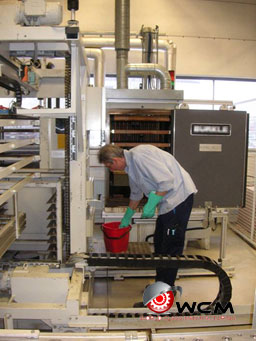Seiso is the third step of the 5S method. It means "to make everything shiny clean". It is the only one-time step in the process.
Goals
The two goals of the Seiso step are:
- To set the new standard for cleanliness
- To learn how to maintain that level of cleanliness

Process
The basics are:
- Assign small teams to work on different sections of the factory
- Clean and inspect everything: machinery, work stations, storage cabinets, open floor spaces…
- Take notes of what had to be cleaned or tidied; how frequently it may be needed; resources required…
- Finish documenting the results by taking a photograph of the final result – this becomes the new standard
Notes
A regular cleaning process can be used as a visual inspection of equipment or the shop facility. Just as you might notice rust or a scratch when washing your car – and not notice it if you just get in and drive – so the workers will have opportunities to catch problems in their early stages. As an example: we had to clean a small puddle of hydraulic fluid – what does this mean about the state of the equipment?
Even this one-time activity ties in with the previous steps of Seiri and Seiton. While performing the one-time "shiny clean" activity, the work teams should ask themselves questions and note the answers:
- Does grime cause problems in operating the equipment?
- Is grit causing the machinery to wear prematurely?
- Is the work station clean enough for safety and comfort?
- What does the "dirt" tell us about the equipment (like the leaking hydraulic fluid example)?
- Is the "dirt" – especially powder, gas or liquid – harmful or toxic?
- What tools, chemicals or methods are appropriate?
- Could careless cleaning actually damage the equipment?
- Could we perform routine maintenance – like checking the engine oil when washing your car – be performed while cleaning?
- Was "dirt" hiding any problems, such as rusting equipment or uneven floors?
TheSeiso step should be applied beyond a factory setting and beyond physical cleanliness. Consider an office cubicle, for example. Is dust accumulating on a stack of papers? Why are the papers sitting there, rather than being filed properly? Are the computer's air vents clogged? Are outdated documents stored on the computer rather than on a network backup?
Again, theSeiso step is a one-time task. However, the final state should be documented so there is a record of how clean the environment should be. As well, Seiso leaves a set of instructions and guidelines for the next 5S step – Seikutsu, the regular standardized cleanup.
How to Make Everything "Shiny Clean" in Lean 5S

The previous article introduced Seiso, the third step in the 5S methodology. Now we address this one-time step in more detail.
- Divide the factory or workplace into a number of areas
- Include equipment and machinery, work stations, storage areas (rooms, cabinets, or tool racks) and open floor areas
- Assign a team to each area
- Normally a two-person team works well, to share the cleaning, thinking and recording tasks
- Train the teams to know what they should do and what they need to report
- Each team cleans their area…more details are listed below
- Each team reports on their findings…more details are listed below
5S - Clean, Inspect and Document
Some principles apply to many cleaning tasks:
- Health and safety considerations:
- Does the worker need gloves, goggles, a mask or a respirator?
- Is equipment powered off? Unplugged? Secured by a lock-out tag?
- Will the task involve heavy lifting? Will enough people be involved to make it safe?
- Are the right tools and cleansing agents available?
- Think about the sources and destinations of the dirt:
- Sawdust may be an unavoidable result of cutting wood. Does it have to settle where it does? Would it make sense to adapt a fume hood to vent the sawdust, rather than needing to clean it up afterwards?
Each actual "cleaning" task has unique features due to the equipment or area being cleaned.
- To clean a surface (a desk or other work surface, or a wall, or a machine cover, or…):
- Just wipe off dirt? Will that scratch paint or enamel? Should we use a specific detergent? Would a vacuum cleaner do a better job?
- To clean a machine:
- How far should it be dis-assembled? Are solvents needed? What tools are required?
- Should lubricants be added?
- Upon inspection: are parts wearing out? Did nuts require tightening?
- Does the "dirt" – for example, a puddle of hydraulic fluid – indicate problems?
- Afterwards: test that it was re-assembled and is now working to specifications.
- To clean a work area:
- Are tools stored properly?
- Are there surfaces or seams where dirt collects?
- Are liquids (or powders, or small objects) stored in spill-proof containers?
- Are documents filed properly, but accessible when needed?
- Is each tool clean and well-maintained?
Make an inspection part of the cleaning process.
- Leakage
- Visible signs of wear
- Metallic powder or shavings may indicate that parts are grinding
- Lubricating oil (as in a car engine): is it clean or cloudy with contaminants?
- Often it makes sense to check fluid levels when cleaning other components.
- Cracks
- Rust
Remember to clean up the cleaning tools!
- Store the vacuum cleaner or broom, the solvents or detergents.
- What to do with a dust cloth? Oily rags? Gloves or respirators?
The team must document what they learned:
- Take photographs to show how clean the work area should be.
- Document what the team did:
- What was cleaned?
- What tools and methods were used?
- Is there a specific sequence that makes the most sense?
- Should better tools or detergents be acquired?
- How long should these tasks take?
- Are major maintenance projects required?
- Repairs to equipment, to the building, to furnishings, to tools?
- Replacement of tools or furnishings?
- Does something need a fresh coat of paint?
Contracting Out 5S – Pro and Con
You may find 5S consulting firms – or just cleaning or engineering contractors – willing to undertake the Seiso step for your organization.
On the positive side:
- Using experienced people can make the process quicker
- You might experience less downtime – especially if the Seiso step is held during a plant-wide vacation period
We strongly advise against contracting out the whole Seiso step, although using consultants as guides and leaders may be beneficial. Compared to completely outsourcing Seiso, full participation has benefits:
- Your workers will learn more if they are fully involved:
- More details about how and where to clean
- Knowing where the cleaning tools and detergents are stored
- People learn better by doing than by reading documents
- Greater sense of ownership ("buy-in") and support for being able to do the cleaning in the available time
- Full employee participation in a team event with visible results leads to improved morale
The Benefits of Seiso in 5S
What are the benefits of the one-time Seiso step in the 5S process? Briefly:
- Setting the standard for future cleanliness
- Learning how to do the cleaning
- Higher morale, especially if managers participate in the event
The benefits of actually having a clean shop – over the long term, not just after the Seiso event – include:
- A safer and more comfortable work environment
- Less downtime for repairs, since equipment will be inspected briefly but regularly; and because there will be less dirt clogging the machinery
- Higher morale: workers can take more pride in a tidy and clean workplace
Lean Standards for Cleanliness
If there are no standards, then no-one can possible live up to them. Worse, people will do as little as required to satisfy themselves, but the effort will be wasted because the next person will either undermine those efforts (because they can tolerate more dirt) or be dissatisfied (because they have higher personal standards).
Here are more positive expressions of the benefits of Seiso in setting standards for cleanliness:
- Understanding how clean a machine or work station must be to:
- Achieve quality goals – for example, dirt might interfere with accuracy
- Reduce wear and tear, thereby achieving the uptime required for throughput
- Be safe and acceptable for the worker
- Be acceptable for visitors, and so eliminate repeated cleanup projects before clients tour the facility?
- Demonstrating that it is possible to achieve that degree of cleanliness.
- Anyone may be sceptical before seeing what actually was accomplished.
Learning Experience
Major benefits of a Seiso step come with what is learned:
- Actually performing the work validates what was planned – or extends the planning with reality.
- Lists of:
- Tasks;
- Tools, equipment, detergents or cleansers required for each task;
- Sequences of tasks – wash the machinery before mopping the floor
- Actual times required by the various tasks
- Repairs required, as noted during the inspections
- Ideas for improvement – when you do the cleaning yourself you will get ideas on how to make the work easier in the future
- Employee buy-in: they did the work and therefore they know it can be done and how long it took to do it the first time
Boost Morale
In Seiso, the employees work in teams, with management participating actively and fully. There is a sense of shared effort toward a common goal, with immediately visible results.
By Oskar Olofsson, author of the book "Succeeding with 5S"
Discover the Revolutionary 5S App
Enhance your 5S implementation and sustenance with our intuitive new app. It offers:
- Comprehensive task management and customizable checklists
- Thorough and easy-to-perform audits
- Exclusive 5S training sessions and interactive workshops
The app is developed by Oskar Olofsson, a renowned Lean expert and acclaimed author of "Succeeding with 5S". Harness the power of Lean management at your fingertips!
Create Your Free Account






